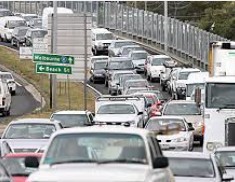
I wrote on Wednesday how both sides of politics plan to sell Victoria’s last major state-owned asset – the Port of Melbourne – in order to fund infrastructure to support Melbourne’s rapidly growing economy. One of the proposed new infrastructure projects – the $8 billion East West tunnel – is reportedly set to reach peak capacity just 12 years after completion, slowing speeds to just 30km per hour. From The Age:
The East West Link is forecast to carry 80,000 vehicles a day on opening in 2019, increasing to between 100,000 and 120,000 a day by 2031, modelling shows…
”If it’s reaching 120,000 we’re at a position where we’re reaching capacity,” Mr Pelosi said. ”Unless you intervene in some manner and manage the toll rate to influence demand, you get a situation where you’re near capacity’…
Cross-examined, he said it would be reasonable to conclude that average speeds would have slowed to about 30 km/h by 2031…
Once again, the folly of Victoria’s economic model – predicated on continuous strong population growth – is on display. Not only is the State looking to sell its last major infrastructure asset in a bid to raise funds necessary to overcome infrastructure bottlenecks caused, to a large extent, by its own population growth fetish. But the resulting infrastructure is set to hit peak capacity shortly after it is due to be built because of population pressures. No doubt, these capacity constraints will then require further significant investment to once again cope with the growing population (chicken meet egg).
Meanwhile, in the Government’s bid to juice gross state product (GSP) through population growth (while GSP per capita stalls), the pre-existing population is forced to continually put up with greater congestion, reduced amenity, and overall lower living standards. It’s also a short-sighted economic model that can only last for as long as the strong immigration and construction continues. As soon as they slow, so does the economy.
As I keep saying, high immigration and population growth is fine if it is for a purpose and fits an overall plan. Otherwise, it is merely uncoordinated ponzi-nomics. Melbourne seems to be following the latter path, with the sale of the Port of Melbourne to band aid over infrastructure constraints seemingly the latest (but definitely not last) manifestation.
unconventionaleconomist@hotmail.com

